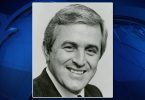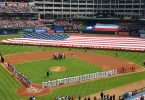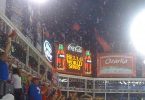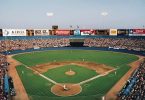Alone among the major sports, baseball offers its patrons the visceral fortuity of a link with its participants.
We see the lush green expanse of the outfield. We smell the hot dogs. We see the players’ faces. We hear the cracks of their bats.
And if we’re blessed, truly blessed, we catch a home run ball.
The internet math varies, but a cursory search suggests there is a roughly 1 in 900 chance of snagging a foul ball at a major league baseball game. For a home run ball, the odds of having one land within reach escalate to 1 in 15,000.
Profound joy generally ensues. It’s not exactly Sistine Chapel, God’s finger touching Adam stuff, but to most baseball fans, it’s close.
Almost everywhere, it seems, but New York.
In the fourth inning of the Texas Rangers’ 12-7 victory Friday night at Yankee Stadium, Adrian Beltre lofted a 1-0 pitch from Masahiro Tanaka into the second row of the right field seats.
The home run carried a footnote to history. It was the 469th of Beltre’s lustrous, certain Hall of Fame career, passing Chipper Jones for third place among third basemen.
But as Beltre did his customary low-impact trot around the bases, the baseball suddenly came bouncing back onto the playing field.

Some New York assclown – that’s him circled in the accompanying photo, wearing the striped shirt – threw the ball back.
Why? Because that’s what they do at Yankee Stadium. They don’t want your team’s home run balls.
You gotta problem wit’ dat?
Well, yes I do.
If the intent is to show defiance or send a message, it ain’t working. Home runs happen. When pitchers surrender homers, they hang their heads, not look to the outfield seats for reconciliation.
As a symbol of Yankee solidarity, it’s weak sauce. The practice didn’t even originate at Yankee Stadium, but Wrigley Field.
Why am I not surprised?
In a 2016 New York Times story, a Cubs fan named Ron Grousl is credited with being the first to throw back an opponent’s home run ball.
There are conflicting versions of the story, but most accounts say it was 1969, and the man who hit the ball into the Wrigley bleachers was Hank Aaron.
“I just thought, ‘Get this out of here. I don’t want it,’” Grousl said. “So I just threw it back. I said, ‘I don’t want this ball.’”
The home run was No. 521 of Aaron’s 755 and it tied him for a few days with Ted Williams on the all-time list.
The gesture became a Wrigley Field custom, passed down through the Cubs’ empty decades, hippie to hipster, Gen Xer to millennial, fueled by bleacher peer pressure, and then proudly invoked during the 2016 World Series for all to see. The Cubs’ version of Pull My Finger.
As Joe Torre, an ex-Yankee manager himself, once elegantly put it, “This has to be one of the dumbest sporting ideas ever.
“Peer pressure gone very bad, in a public setting. To me, that’s the greatest souvenir in the world, and you throw it back?”
The reaction on Friday’s Rangers telecast was no less priceless.
As Fox Southwest replayed what went on in the outfield seats, C.J. Nitkowski commented, “What wasn’t wise was throwing that ball back in. What is wrong with you? Adrian Beltre hits a home run. He’s going to the Hall of Fame. You get your hands on a home run ball from a Hall of Famer, and you throw it back on the field because you don’t want people to boo you?
“That is ridiculous.”
Beltre’s homer, the cameras showed, actually caromed into the hands of what appeared to be the perpetrator’s son. (That’s the kid on the left in the photo, wearing the Fitch 1892 shirt)
“I’ve never understood this,” said Rangers announcer Dave Raymond.
The replay showed the dad, wearing cargo shorts and a shirt with pink, blue and gray horizontal stripes, demanding the ball and then lofting a lollipop back towards the field that failed to even reach halfway to the infield.
“Then that throw . . . ,” said Nitkowski, whose disgust was comical, but real. “But at the same time he’s got pink stripes on his shirt, so I can see why. It wasn’t the only bad decision he made today.”
For the record, throwing a baseball back onto the field is prohibited at Globe Life Park, as it is at most major league stadiums. The Rangers aren’t militant about it, but fans throwing anything onto the field are subject to ejection and possible arrest.
In the NFL, players who throw touchdown balls into the seats are fined $6,076 for the first offense, $12,154 on the second. The league says it’s a fan safety issue.
Sure enough, in last week’s preseason game at MetLife Stadium, the Browns’ David Njoku caught a touchdown pass and politely underhanded the football to a fan in the end zone front row.
It turned out to be a Giants fan from New Jersey, who rifled the ball right back at Njoku.
Clearly, this has become a New York thing.
Which is too bad, because catching a ball – foul ball or home run — at a baseball game remains one of sport’s signature experiences.
Dads and sons – and daughters – all have a story of that night they were in the right place, at the right inning, when a batter whose name they will always remember hit the ball that magically found their hands.
That moment for my then-12-year-old son and I came in May of 1991 at old Arlington Stadium. The Rangers were playing the Detroit Tigers and, though a Nolan Ryan start probably doubled the crowd, there still was plenty of elbow room in the upper deck behind home plate.
In the second inning, ex-Ranger Pete Incaviglia, a newcomer to the Tigers, took a mighty, Inky-like swing and fouled a Ryan fastball high overhead. The ball banged off the concrete behind us and rebounded directly into my hands.
My son beamed. After all, the last hand to touch the ball had been Nolan’s.
“Dad, do you think you can get him to sign it?” he asked.
John Blake, Rangers public relations director and clubhouse gatekeeper, is not going to like this, because the media is not allowed to seek autographs. But I confess – while my son waited outside, I used my media credential to creep into manager Bobby Valentine’s office and explain my fatherly predicament. He gave his blessing.
By the way, I asked him, what is this? There was a two-inch yellow streak down one side of the ball.
As the story goes, Ryan was an old schooler who never shied away from anything that might help him better spin the baseball.
Valentine studied my ball like a 34th Street jeweler. “Well, it’s not what you think it is,” he said at length. “Come with me.”
We went to the Rangers’ clubhouse bat rack, where Valentine extracted a black Worth-brand bat trademarked with yellow paint.
“Incaviglia uses this same kind of bat,” Bobby said, mystery solved. “That’s where the yellow came from.”
I waited until Nolan was alone before explaining why I wished to have his signature. I remember the conversation to this day.
“Where were y’all sitting?” Ryan asked in his familiar drawl.
“Upper deck, front row, a little to the right of home plate,” I told him.
“Incaviglia?” Nolan replied.
The great Ryan’s career spanned 27 seasons and 5,386 innings. Yet he could remember where foul balls were deflected three hours after he threw them.
“What’s your boy’s name?” he asked.
Which is how my now-adult son still owns a baseball that reads, “To J.P., Best wishes, Nolan Ryan.”
Not exactly a Sistine Chapel moment, but close enough.







